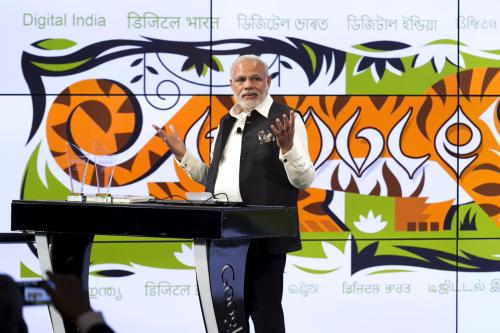Content from the Brookings Institution India Center is now archived. After seven years of an impactful partnership, as of September 11, 2020, Brookings India is now the Centre for Social and Economic Progress, an independent public policy institution based in India.
This article first appeared in The Indian Express. The views are of the author(s). The Bengali translation of the article can be found here.
Infosys plans to curry favour with the Donald Trump administration with a promise of creating 10,000 new American jobs. We should note that the first of four “Technology and Innovation Hubs” promised by Infosys will be in Indiana. No doubt, this is designed to charm Vice President Mike Pence by bringing tech jobs to his home state, hitherto known primarily for producing the highest number of basketball players per capita.
Infosys’ munificence is also laced with a profound irony as America edges towards full employment: The jobless rate is down to 4.4 per cent, the lowest in a decade. In the meantime, back on Infosys’ home turf, a bloodbath ensues. Wipro laid off 600 employees recently; Cognizant plans to let go of 6,000 and Infosys has “released” 8,000-9,000 employees in the past year. These statistics are significant; the IT sector employs 3.9 million people, almost a quarter of India’s formal workforce. Nasscom (National Association of Software and Services Companies), projects that the industry’s 30-plus per cent growth of years past is history and we shouldn’t count on more than 8-10 per cent growth in the foreseeable future.
With Infosys innovation being thrust upon Indiana, you must be wondering what will happen inside the soon-to-be-formed hubs. Have no fear; we can always find something for them to do. Here are five innovation-worthy projects the Indiana hub could get to work on right away. They might help address the more fundamental problems that Infosys faces.
One, keeping humans working when automation can do the work. No doubt, one of the biggest reasons for the job losses in the Indian IT sector is the trend towards greater automation. According to a global analysis by McKinsey, four countries alone — China, India, Japan, and the US — will account for just over half of the wages affected and almost two-thirds of employees whose jobs can be automated by adapting demonstrated technologies. Of these four countries, India is youthful; for the rest, given aging populations, automation would make perfectly good sense. According to McKinsey, about half of the Indian IT sector workers will be “irrelevant” in the next four years. In India, with the world’s youngest population with 80-90 per cent of workers already in the informal sector, this cannot be cheerful news.
Two, reinventing an outmoded outsourcing model. Beyond the threat of automation, there are other dark clouds, literally, gathering over the IT horizon. Infosys and its peers had built a $150 billion a year business based on installing and maintaining custom software on their clients’ systems using low-cost programmers. This model is being displaced by off-the-shelf software services that run on the “cloud.”
How the clients are buying, how they pay and the entire competitive market is changing — and changing fast. Infosys is no longer just competing with local peers, Wipro and TCS, but with global heavyweights, such as Amazon, Oracle and Microsoft and smaller nimbler start-ups. While the Indian IT sector managed to survive earlier transitions, from mainframe to client-server and the rise of e-commerce and mobile applications, this time the game has changed. Cloud services, in combination with big data, machine learning and artificial intelligence, require very different selling strategies, pricing and technical skills. Reinventing the model is bound to be tricky. It is too tempting to try to hold onto the old business as long as possible because it is familiar and helps pay today’s bills. Starting afresh is risky, especially when it involves giving up on precisely what had worked quite nicely in the past.
Three, skilling before getting to re-skilling. An essential part of the transition to a new model is to re-train employees and prepare them with more complex skills involving emerging technologies and client-centric capabilities, such as “design thinking.” The problem for Infosys and its industry peers is that it must confront the grim reality that the vast majority of the 80,000 engineers churned out each year by universities in India are inadequately prepared even for the old jobs. In 2011, Nasscom had declared that only a quarter of India’s engineering graduates were employable. Six years on, the situation might be getting worse. No wonder Infosys and its peers run extensive re-training programmes, including those in design thinking; but now the complexity and costs of re-engineering the engineers has just gone up.
Four, closing the digital competitiveness gap. With low-cost programming becoming less essential to the service model, Infosys and its peers must find new ways to regain a competitive position. Historically, the banking and financial services and telecommunications industries accounted for half of the revenues of the Indian IT sector. The future demand growth is from other industries, such as retail and healthcare, with greater needs for “digital services”: Solving core business problems by harnessing the emerging digital technologies. International IT competitors with business consulting operations have closer ties to these emerging client segments and are better configured to play in this new space.
No doubt, the Indian IT players have begun to adapt. Infosys’ AI (artificial intelligence) platform generates 5-6 per cent of revenues, from zero only a few years ago. TCS claims its digital services are growing at 10 per cent a year. That said, an analysis from Livemint shows, that Infosys, TCS and Wipro had 50 per cent more employees in digital services and earned 40 per cent less revenue than Accenture, their primary international competitor. Accenture made more than twice the revenue-per-employee in digital relative to its legacy operations, while for Infosys and its peers, the revenues-per-employee were about the same across digital and legacy services. This suggests that Indian IT not only lags in productivity, it is also not playing in the same high-profitability strategic space as the global competition.
Five, adapting to other fast-growing markets. The US accounts for 60 per cent of the revenues of the Indian IT sector. However, there are other markets that are evolving quickly according to the Digital Evolution Index that we have created at The Fletcher School at Tufts to track the world’s digital momentum and patterns. These digitally growing markets have faster-moving economies and large population clusters, especially in Asia. Might this be an opportunity for a renewed competitive edge for Indian IT? It may be time for the majors to re-visit the “where to play” question and reduce its dependence on the US.
Infosys’ curry diplomacy was, no doubt, inspired by Donald Trump’s “Buy American, Hire American” order and his threat to revise the H-1B visa programme. I am not convinced that extravagant job-creation programmes in the US are the best use of Infosys’ increasingly scarce resources. While the Bengaluru-based IT giant may know how to mix its spices, to “curry favour” is a phrase that, oddly enough, has little to do with treating someone to a mean curry. Its obscure origins are in the grooming of horses: “To curry” is “to brush”. By spending resources on creating thousands of tech jobs in a country where the administration is gutting resources for science and technology programmes in an industry rapidly being automated, it seems Infosys is bringing the wrong curry and backing the wrong horse.









Commentary
Op-edThe art of curry diplomacy
May 15, 2017